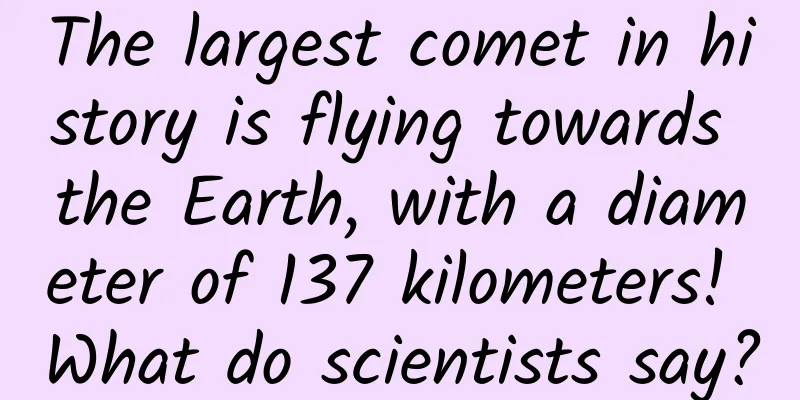The largest comet in history is flying towards the Earth, with a diameter of 137 kilometers! What do scientists say?

|
According to foreign news reports, NASA recently confirmed through the Hubble telescope that a huge comet numbered C/2014 UN271 is flying towards the Earth at a speed of about 9.72 kilometers per second and is now about 3.2 billion kilometers away from us. The diameter of this comet is about 137 kilometers, about 1/3 the size of Hainan Island, and its mass is about 500 trillion tons. The asteroid that destroyed the Earth's ecology and wiped out the dinosaurs 65 million years ago was only 10 kilometers in diameter. What would happen if this giant comet hit the Earth? An asteroid impact 65 million years ago changed the direction of species evolution Asteroid impacts are one of the biggest threats to life on Earth. A slightly larger asteroid could cause a fatal blow to the Earth's ecology. Life on Earth was born about 4 billion years ago, but the real explosion of visible life was in the Cambrian period, which is 540 million years ago. Modern scientific investigations and research believe that the largest asteroid impact after the emergence of visible life on Earth occurred 65 million years ago. At that time, dinosaurs had dominated the Earth for 160 million years, and environmental changes had become increasingly unsuitable for the existence of such large reptiles. To make matters worse, an asteroid with a diameter of about 10 kilometers hit the Earth, leaving a crater with a diameter of about 180 kilometers in what is now the Yucatan Peninsula in Mexico. According to some research data, the asteroid hit the earth at a speed of about 20 kilometers per second, and the impact energy reached the explosion equivalent of 120 trillion tons of TNT. The dust and magma raised by the impact covered the sky and caused fire to fall from the sky; the earth's crust broke, and volcanoes and earthquakes erupted around the world; the tsunami reached hundreds of meters, and the impact submerged the continent. Countless creatures were killed or injured at the time, and the surviving plants and animals were soon hit even harder. As the smoke and dust covered the sky, plants that could no longer photosynthesize died one after another, and animals that depended on plants for survival also starved to death. The food chain was broken, and hunger and plague caused the death of various animals one after another. This disaster completely changed the earth's environment, and the aftermath lasted for millions of years. 85% of species became extinct, and new life forms began to emerge. The biggest change in plants was the reduction of evergreen plants and the emergence of deciduous plants; the change in animals was the end of the world of reptiles, and mammals gradually became the masters of the earth, and the seeds of human beings were also bred among them. From then on, the direction of species evolution completely changed. If C/2014 UN271 hits the Earth, life on Earth will have to restart 65 million years ago, a 10-kilometer asteroid hit us, changing the direction of evolution forever. Now a 137-kilometer comet is hurtling toward us, so the consequences must be even more serious. So how serious are they? Let's first calculate the impact energy. Using the formula E=1/2mv^2, we can get the energy of this 500 trillion ton comet hitting the earth at a speed of 9.72 kilometers per second, which is 2.4*10^25J (joules), equivalent to the explosive equivalent of 56.45 trillion tons of TNT. What does this mean? The total equivalent of nuclear bombs in the world is about 10 billion tons of TNT. If a nuclear war breaks out, many professionals claim that it can destroy humanity several times. Then the impact energy of this comet is equivalent to 564,500 times the total amount of nuclear bombs in the world. How many times will it destroy humanity? We can describe it like this: this energy can at least create a big hole in the earth's crust, causing magma to splash, tsunamis, global earthquakes and volcanic eruptions. When the first wave of impact passes, the smoke and dust that covers the sky will lock the sunlight for several years. The nuclear winter will cause the earth to be left with no grass and covered by thick glaciers. For life on Earth, there is only destruction, and only tiny organisms can survive. This also indicates that life on Earth will not be completely destroyed. Those remaining tiny organisms will survive the most difficult period and adapt to the new environment. From then on, life will restart, and plants and animals will re-evolve from the original start, and the direction of life on Earth will be completely changed. Tens of millions of years later, perhaps intelligent life will emerge. But all this has nothing to do with the extinct humans. When new intelligent creatures develop, they may learn through archaeological discoveries that there was a human civilization in prehistoric times. The new rulers of the earth may think that prehistoric humans are strange animals with well-developed limbs and simple minds, which are ugly. We don't need to be surprised at all, this is just a kind of equal treatment. Because the intelligent creatures of the future are nothing like us humans today, and according to our current aesthetic standards, they must be very, very ugly. And their archaeological discoveries will also make us think we are ugly. Learn more: What is a comet? Comets are actually a mixture of ice, snow and dust wandering at the edge of the solar system. In the early days of the formation of the sun, a strong stellar wind was generated, blowing some light materials such as gas, water vapor, and dust in the planetary disk far away. The edge of the solar system is a dark and cold world. The low temperature of more than 200 degrees below zero will freeze these light materials into ice and snow particles. Under the influence of mutual collision and gravity, they will become larger and larger, becoming "dirty snowballs". This is the ancestor of comets - the comet nucleus. In fact, the nucleus of a comet is an ice cube made of water, ammonia, methane, hydrogen sulfide, hydrogen cyanide, formaldehyde, etc. mixed with solid dust. However, this ice cube contains impurities, so it is not white at all, but a black dirty snowball. Scientific research shows that the smell of a comet is not pleasant, a bit like the smell of rotten eggs, horse urine, alcohol and bitter almonds mixed together, in layman's terms, it is the smell of a stinky fart. These asteroid fragments composed of ice and snow mainly float in the Kuiper belt (outside the orbit of Neptune) and the Oort cloud belt, and some also come from the asteroid belt between Mars and Jupiter. Their orbits are unstable, and due to the gravitational pull of the large planets, they will drift, just like ping-pong balls bouncing around in the solar system. Gradually, some dirty snowballs are pulled by the gravity of the sun and form orbits around the sun. In ancient times, these dirty snowballs were discovered by humans when they were close to the sun and were called comets; now comets can be captured by telescopes at a greater distance from us. The typical features of a comet are a nucleus, a coma, and a tail. When it is close to the sun, it looks like a shining broom, so it is also called a broom star. The nucleus of a comet is the solid part at the core. The small one is several hundred meters in size, and the large one is several kilometers to more than ten kilometers in size. C/2014 UN271 is the first one to reach 137 kilometers. The coma is the evaporation of the comet. When a comet flies towards the sun and is exposed to sunlight, the surface temperature will gradually rise. The various gases that make up the comet mixed with dust will sublimate and evaporate, forming a foggy circle around the nucleus. The closer the coma is to the sun, the larger and brighter it becomes, with a diameter of hundreds of thousands to millions of kilometers. Some comets also have a circle of cometary clouds outside the coma, which is a cloud of rarefied hydrogen atoms and can be 1 to 10 million kilometers in diameter. Comet tails only appear when a comet is 300 million kilometers away from the sun. They are the shiny tails trailing behind the comet. Comet tails are generally broom-shaped, and they get bigger the closer they are to the sun. They can be as wide as 24 million kilometers at their widest and as long as hundreds of millions of kilometers. Comet tails always face away from the sun. When a comet is away from the sun, they are in front of the comet, indicating that comet tails are produced by sunlight radiation. Both the coma and the tail are very thin. The particle density of the coma is only one billionth of that of the Earth's atmosphere. The tail of the comet is even thinner because it is mainly composed of charged ions. The tail of the comet is affected by the solar wind and has various shapes, which I will not introduce one by one here. Comet numbers and periods There are many comet nuclei in the solar system, estimated to be as many as trillions. These comet nuclei are basically far away from our Kuiper belt and Oort cloud belt. Most of them will not come near the sun, and only a few will enter the planetary circle. So far, the scientific community has discovered more than 1,600 comets, but only two can be seen by the naked eye, namely Halley's Comet and Hale-Bopp Comet. These comets come from different places, some far away, and so there are short-period satellites and long-period satellites, with a period of 200 years as the boundary. Satellites with a period of less than 200 years are short-period satellites, with the prefix "P/"; satellites with a period of more than 200 years are long-period satellites, with the prefix "C/". The comet with the shortest period discovered so far is Comet Encke (2P/Encke), with a period of only 3.3 years and an aphelion of only 4 AU (astronomical unit, 1 AU is about 150 million kilometers). Therefore, the home of this comet is in the asteroid belt between Mars and Jupiter. The first comet discovered by humans was Halley's Comet (1P/Halley), which has an orbital period of 76 years. Its aphelion is 35.1AU, and it is obvious that its home is in the Kuiper Belt beyond the orbit of Neptune. When this "broom star" appeared, people did not know what a comet was, so they regarded it as a monster and a disaster star, believing that it would bring war, floods, famine and plague to mankind. However, scientists did not believe in it and quickly calculated its orbital period, knowing that it would come back every 76 years and was a natural phenomenon. It is no wonder that more and more comets appeared later. Comet Hale-Bo (C/1995 O1) is the comet with the longest orbital period before C/2014 UN271, with an orbital period of 2533 years. The comet passed perihelion on April 1, 1997, at a distance of about 0.914 AU from the Sun, and aphelion at about 370.8 AU. This satellite obviously comes from a world farther than the Kuiper Belt, and is already in the Oort Cloud. It is still an unfamiliar world to humans. So far, Voyager 1, the farthest unmanned probe flown by humans, has been flying for nearly 45 years at a speed of 17 kilometers per second, and has only flown 22.3 billion kilometers, which is still far from Hale-Bo's hometown. C/2014 UN271, discovered in 2014, has become the comet with the longest orbital period ever discovered. Its aphelion is 54,000 AU, or about 8.1 trillion kilometers. It takes 4.5 million years to make a round trip. This is a comet from almost the edge of the Oort Cloud. Scientific research believes that the boundary of the Oort Cloud is about 1 light year away from the sun, or about 63,067 AU. So, will C/2014 UN271 hit the Earth? It is currently heading towards us at high speed, and based on the current trajectory, scientists believe that it will not hit the Earth. C/2014 UN271 will reach its closest point to the Sun in 2031, but this point is about 10.7 AU from the Sun, or about 1.6 billion kilometers, which is outside the orbit of Saturn, so the Earth is safe. But this is only an estimation of the current trajectory. The problem is that comets themselves are celestial bodies that are pulled into the orbit of the solar system by the gravitational disturbance of large celestial bodies. After entering the planetary circle of the solar system, they will be affected by the gravitational disturbance of the major planets. Will their trajectory shift? However, the trajectory of this comet is very special. It does not come from the ecliptic plane, but "falls from the sky", that is, it comes almost vertically from the ecliptic plane of the solar system. This is enough to prove that this comet comes from the Oort Cloud. Scientific research believes that the Oort Cloud is a sphere surrounding the solar system, and the orbit of C/2014 UN271 once again provides evidence for this. In this way, the comet will not move along the orbital planes of giant planets such as Neptune, Uranus, Saturn and Jupiter. Therefore, it is mainly pulled by the gravity of the sun and is less affected by the gravitational disturbances of other large planets. Therefore, the risk of Comet C/2014 UN271 hitting the Earth is extremely small, and you can sleep well. So, will people be able to see the glorious image of this comet? Unfortunately, it is difficult for ordinary people to see it. Because when it enters the perihelion, it is still very far away from us, outside the orbit of Saturn. C/2014 UN271 itself is just an irregular comet nucleus with a diameter of about 137 kilometers. At such a distance from the sun, even if there is a coma or tail, it will not be very large, so the brightness is very low. According to scientific calculations, the brightness of the comet will be only 16th magnitude, which is weaker than Pluto. It is impossible for human eyes to see it, and it can only be seen with a telescope larger than 200 mm. Therefore, the comet passing by the earth will only be a scientific event, and ordinary people will not notice it at all, so they can just eat and sleep. What do you think about this? Welcome to discuss, thank you for reading. The copyright of Space-Time Communication is original. Infringement and plagiarism are unethical behavior. Please understand and cooperate. |
>>: Why is toilet paper embossed? It’s because…
Recommend
Do you really understand product operations?
Internet products have only been proposed as an i...
How much does WeChat Mini Program certification cost? Is there any charge for WeChat Mini Program authentication?
Before businesses start developing WeChat mini-pr...
Understanding the current status and cutting-edge technologies of cloud databases in one article
"Everything will run in the cloud." Now...
A woman died while taking care of her baby outdoors! Be careful about this in summer!
Recently, high temperatures have occurred in many...
Learn about the North and South Pole
1. Polar Overview Polar refers to the South Pole ...
Zhaocaibao: What are the risks behind innovation?
The Internet industry and the financial industry ...
Cocos Studio V2.1 Open Plan Announced
On December 19, Cocos Studio, a product of the Co...
Liu Yang portrait 2021
Liu Yang Portrait Retouching 2021 Resource Introd...
Community management is difficult, monetization is poor, and death is fast. 5 tips to teach you how to master the essence of refined community operation
What is a real community ? The people on the bus ...
World Thalassemia Day: Difficult to treat but preventable! 9 pictures to help you understand thalassemia
May 8, 2023 is the 30th World Thalassemia Day (Wo...
Is it easy to get a brain tumor if you play with your phone for a long time? Is it related to the radiation from the phone? People who love playing with their phones may want to read this
Recently, a 37-year-old man suffered from dizzine...
Inositol, is it really that magical?
This is the 4774th article of Da Yi Xiao Hu Recen...
In the live streaming melee, will the five major camps of YY, Yingke, Momo, KK and Douyu be formed soon?
With the rise of internet celebrities such as Pap...









